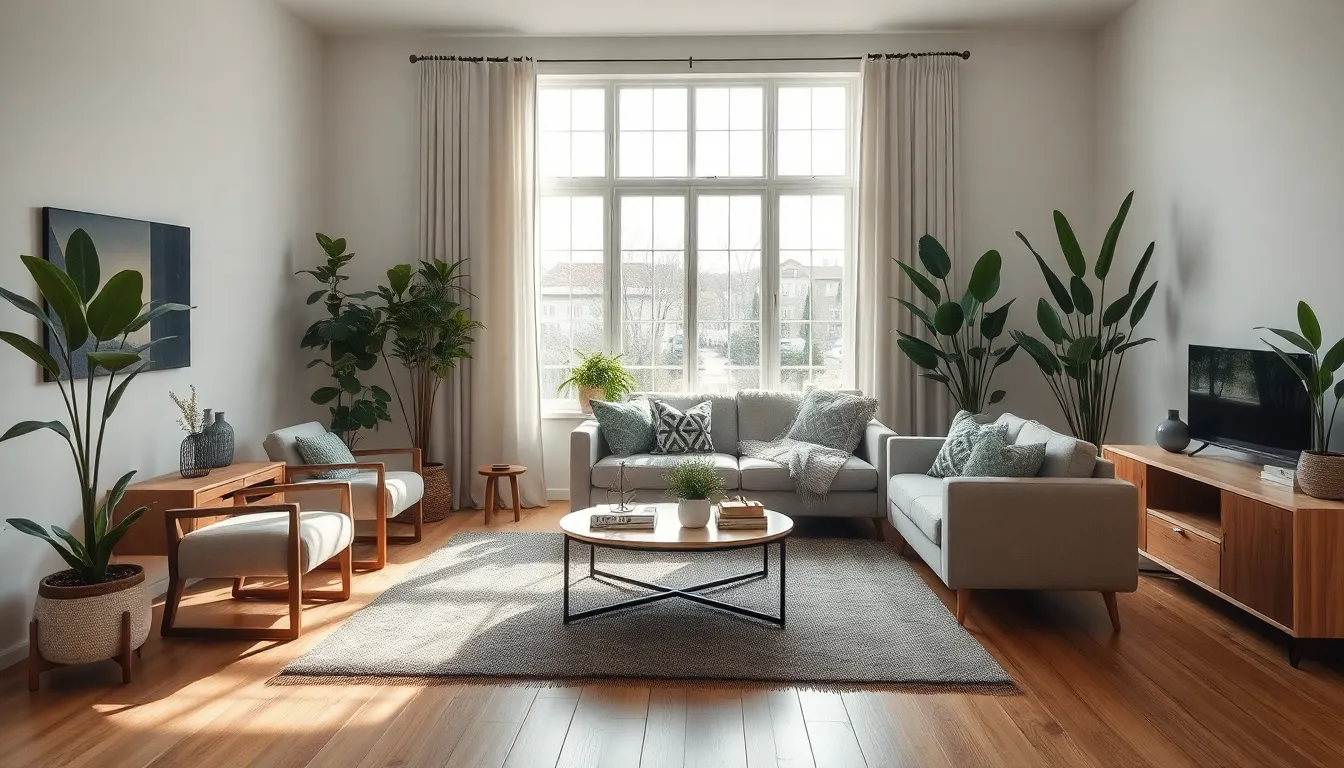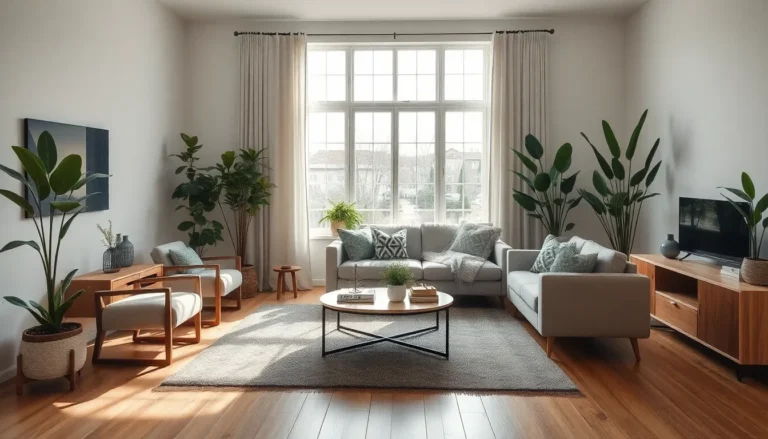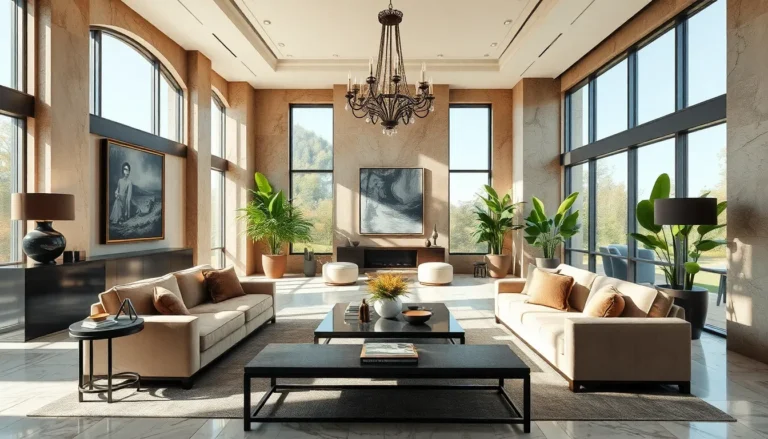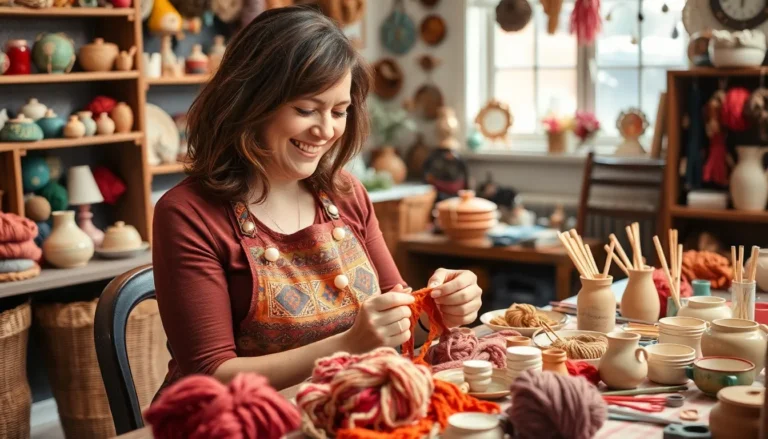Table of Contents
ToggleInterior design isn’t just about choosing a pretty couch or the right shade of paint. It’s like creating a personal stage where life unfolds, and every theme tells a story. Whether it’s a cozy farmhouse vibe or a sleek modern aesthetic, the right theme can transform a mundane space into a sanctuary that reflects personality and style.
Overview of Interior Themes
Interior themes play a critical role in defining a space’s atmosphere. Each theme reflects distinct styles and functions, contributing to the overall aesthetic and mood of a room. Common themes include modern, traditional, minimalist, industrial, and farmhouse.
Modern designs focus on clean lines, neutral colors, and functional furnishings. Traditional themes emphasize classic elegance with ornate decor and rich textures. Minimalist interiors prioritize simplicity, utilizing a limited color palette and uncluttered spaces. Industrial aesthetics incorporate raw materials, exposed pipes, and a utilitarian vibe. Farmhouse themes, known for their rustic charm, often feature vintage elements and cozy layouts.
Understanding different interior themes enhances the selection of appropriate decor and furnishings. Selecting a theme allows individuals to convey personal preferences and create cohesive environments. Each theme can be adapted to fit various settings, making it versatile for any room.
Mood and functionality significantly influence theme choices. Spaces designed for relaxation may benefit from warm colors and soft textures, while workspaces thrive on efficient layouts and calming tones. Additionally, elements such as lighting and accessories complement selected themes, reinforcing desired atmospheres.
Fashion and trends evolve, impacting interior themes over time. While timeless elements remain, new elements frequently emerge, such as biophilic design, which integrates natural features into interiors. Adapting themes to current trends keeps spaces fresh and inviting.
Interior themes encapsulate a space’s character. They encompass an array of styles, fostering individuality and enhancing everyday life experiences.
Popular Interior Themes
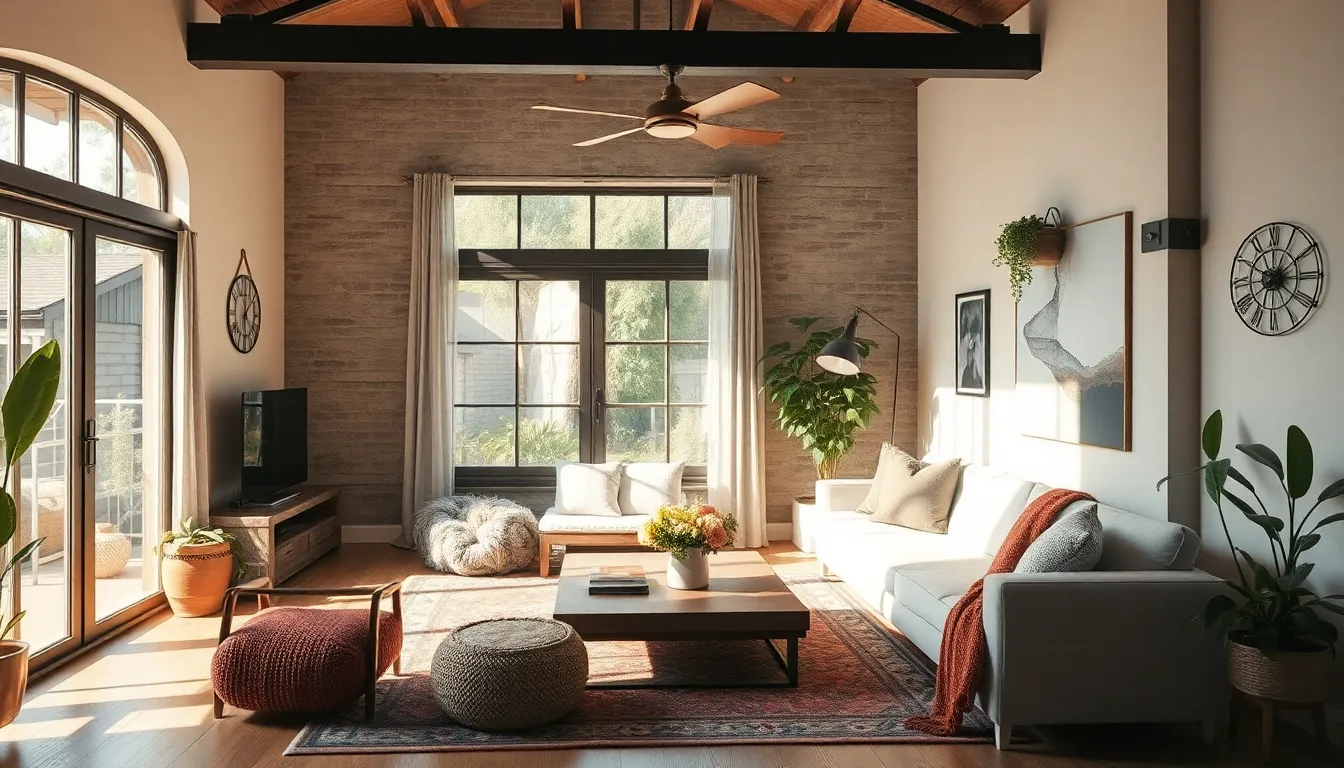
Interior themes shape the emotional landscape of a space, creating environments tailored to individual preferences. Various popular themes exist, each offering unique characteristics and feelings.
Modern Minimalism
Modern minimalism emphasizes simplicity and functionality. Clean lines define this style, creating uncluttered spaces that evoke a sense of calm. Neutral color palettes, like whites, grays, and beiges, enhance the airy atmosphere. Natural materials, such as wood and stone, add warmth without overwhelming the design. Furnishings often feature multi-functional pieces, maximizing utility while maintaining elegance.
Rustic Charm
Rustic charm encapsulates a cozy, inviting ambiance. Natural wood, exposed beams, and earthy tones dominate this theme, promoting a connection with nature. Textiles like wool and linen contribute to the warmth felt in a rustic space. Handmade elements, including pottery and vintage accessories, add character and authenticity. This theme suits cabins, cottages, or any space aiming to create a homey feel.
Industrial Style
Industrial style draws inspiration from warehouses and factories. Raw materials, such as metal, wood, and concrete, play a significant role in this design. Open spaces, high ceilings, and large windows allow light to cascade through, enriching the atmosphere. Furniture often showcases vintage or repurposed items, enhancing the urban aesthetic. This theme suits lofts and open-plan homes, merging functionality with edgy style.
Bohemian Vibes
Bohemian vibes champion creativity and individuality. Layered textiles, vibrant colors, and diverse patterns define this eclectic style. Furnishings are often a mix of vintage finds and artisan-crafted pieces, contributing to a carefree atmosphere. Plants play a vital role, adding life and freshness to any environment. This theme allows for personal expression, making spaces feel unique and welcoming.
Choosing the Right Interior Theme
Selecting an interior theme aligns closely with both personal preferences and the functionality of each room. It’s essential to evaluate these elements for a cohesive design.
Personal Preferences
Identifying personal tastes plays a crucial role in determining the right interior theme. Individuals often gravitate toward styles that resonate with their lifestyles and values. For example, someone who cherishes tranquility might prefer a minimalist theme, while another person who enjoys vibrant colors may lean toward bohemian aesthetics. Considering how colors, patterns, and materials evoke emotions allows for a more favorable and personalized space. Enthusiasts of vintage decor often find joy in traditional themes, which celebrate elegance and history. Ultimately, choosing an interior theme that mirrors personal identity creates a comforting and inviting atmosphere.
Room Functionality
Room functionality significantly influences theme decisions. Each area in a home serves a specific purpose, dictating the design approach. For instance, a home office requires a modern aesthetic with clean lines for productivity, whereas a living room benefits from a cozy farmhouse theme that encourages relaxation. Understanding the room’s function helps refine selections for furniture, lighting, and color schemes to enhance usability. Spaces meant for entertaining may adopt industrial designs that encourage social interaction. Prioritizing functionality alongside aesthetic appeal ensures that each room supports its intended activities effectively.
Tips for Implementing Interior Themes
Successfully implementing interior themes enhances the overall ambiance of a space. Attention to detail in color selection, furniture choices, and accessories contributes significantly to achieving a cohesive look.
Color Schemes
Choosing the right color scheme lays the groundwork for any interior theme. Start with a dominant color that represents the desired mood, whether calm or vibrant. Neutrals often provide a versatile backdrop for bold accent colors. Incorporate color psychology; for instance, blue evokes tranquility, while yellow introduces warmth. Ensure colors complement each other; use a color wheel to identify harmonious combinations. Select two or three primary colors and apply them throughout the space for consistency. Testing paint samples helps visualize how colors interact with natural light at different times of the day.
Furniture Selection
Furniture selection shapes the functionality and style of a room. Prioritize pieces that align with the chosen theme; minimalist designs favor clean lines, while rustic styles focus on natural materials. Consider scale and proportion; oversized furniture can overwhelm a small space, while too-small pieces may feel lost. Comfort remains essential, especially in living areas; try out sofas and chairs before making a purchase. Balance aesthetics with practicality; look for furniture with multifunctional uses, like ottomans that provide storage. Layer different textures through fabric choices to add depth and interest to the overall design.
Accessories and Decor
Accessories and decor bring personality to an interior theme. Start with statement pieces that draw attention, such as artwork or large planters. Incorporate a mix of shapes and sizes; using varied heights creates visual intrigue. Choose decorative items that reflect personal interests, like books or travel souvenirs, which can spark conversations. Balance the space with functional decor, such as stylish lighting fixtures that enhance both aesthetics and usability. Don’t forget to incorporate plants, as they add life and contribute to air quality. Regularly rotate accessories to refresh the atmosphere; this approach keeps the space dynamic and engaging.
Choosing the right interior theme is essential for creating spaces that reflect personal identity and enhance daily experiences. Each theme offers a unique way to express individuality while catering to the functionality of different rooms. By understanding the characteristics of various styles individuals can make informed decisions that elevate their home environment.
Incorporating thoughtful design elements such as color schemes furniture choices and accessories allows for a cohesive and inviting atmosphere. As trends evolve staying adaptable ensures that spaces remain fresh and engaging. Ultimately a well-executed interior theme transforms a house into a true sanctuary.

